Back in 2023, reports began to surface that Iran was sending weapons to Russia across the Caspian Sea for use in the war against Ukraine. Both Tehran and Moscow have continued to deny these claims, with Russian Foreign Minister Sergey Lavrov dismissing them as “invented falsehoods.” Yet transport data obtained by the Center for Advanced Defense Studies (C4ADS) and analyzed by Meduza indicates that Iran may have supplied Russia with more than 4,000 metric tons of ammunition in a single month last year. Meduza shares evidence that Moscow is, in fact, buying weapons from Iran.
Iran may have supplied Russia with more than 4,000 metric tons of ammunition in a single month of 2024, according to transport data provided to the nonprofit C4ADS by an anonymous source in the logistics sector.
The records, analyzed by Meduza, cover state-owned rail container shipments from November 1–28, 2024. They show that Russian Railways moved up to 4,610 tons of “explosive materials” from the port in the village of Olya in Russia’s Astrakhan region to two military sites near the Ukrainian border.
C4ADS analysts, who have extensive experience with such data, note that the Russian military often uses the label “explosive materials” for shipments arriving from Iran and North Korea.
From the Caspian to the front
On November 10, 2024, one of the trains carrying “explosive materials” departed from Port Olya in Russia’s Astrakhan region. Planet Labs satellite images and maritime transportation data from the tracking platform Windward show that earlier that day, the Russian cargo ship PORT OLYA-1 had docked at the local pier. The vessel regularly runs between Russia and the Iranian ports of Amirabad and Fereydunkenar on the Caspian Sea.

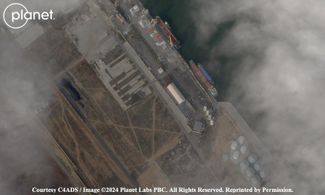
The satellite images also show a line of containers stretching from the ship inland. PORT OLYA-1 almost certainly unloaded these containers directly onto the rail lines running into the port, says Ruslan Leviev, founder of the independent investigative group Conflict Intelligence Team (CIT), who also examined the images.
Port Olya is a key hub in the transport corridor between Russia and Iran. The two countries use it to trade grain, lamb, and, as Bloomberg has reported, weapons. The outlet found that more than a quarter of Iran’s arms shipments to Moscow are handled by businessman Hossein Shamkhani, an oil magnate and the son of Ali Shamkhani, an adviser to Iran’s Supreme Leader Ayatollah Ali Khamenei.
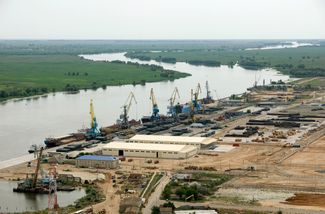
A controlling stake in the port is owned by businessman Dzhamaldin Pashaev, who was placed under U.S. sanctions in 2024. The U.S. Treasury Department said that since 2021, Pashaev’s companies had signed more than 200 agreements tied to the transport of military cargo. “Pashaev and his companies have been integral to the ongoing transfer of lethal aid to U.S.-designated Russian Joint Stock Company Special Economic Zone of Industrial Production Alabuga (), which has been one of the primary assembly plants of UAVs for the Russian Ministry of Defense, with support from Iran,” the department stated.
That same round of sanctions also targeted other cargo ships used to move Iranian weapons to Russia: the PORT OLYA-2, the PORT OLYA-3 — which is known to have carried Iranian Fath-360 short-range tactical missiles — and the PORT OLYA-4. All of these vessels, including the PORT OLYA-1, belong to MG-Flot, another company to Pashaev.
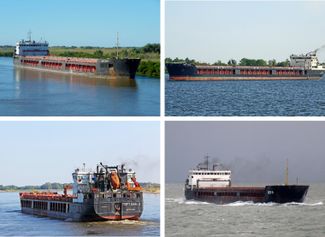
From Port Olya, containers carrying “explosive materials” were transported to railway stations in Kotluban, in Russia’s Volgograd region, and Lukovskii, in North Ossetia, according to the records provided to C4ADS. Both sites have major ammunition storage depots run by the Russian Defense Ministry’s 1060th Center for Material-Technical Support, which supplies frontline troops.
Satellite imagery of the Kotluban depot shows more containers appearing there in November, says Leviev, who examined the images. “Ammunition deliveries are clearly continuing,” he told Meduza.
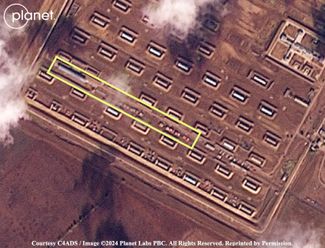
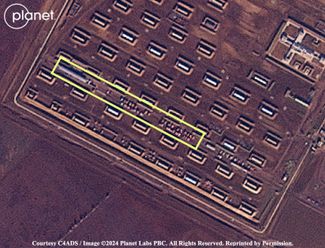
As much as 17 percent of all shipments to the Kotluban depot come from Iran, according to a report by the KSE Institute, a think tank at the Kyiv School of Economics, which also analyzed maritime deliveries through Port Olya (albeit without specifying its data sources). Kotluban also receives arms from North Korea: they arrive first by sea at the Russian Far East port of Nakhodka and are then transferred by rail. Analysts at C4ADS say the Lukovskii depot likely stores weapons from both countries as well.
Deliveries of “explosive materials” from Iran and North Korea to Russia rose from 150,000 tons in 2023 to 260,000 tons in 2024, according to KSE analysts. Shipments across the Caspian Sea through Port Olya account for only a fraction of that total — about 13,000 tons annually, by KSE’s estimates. Meduza and C4ADS tracked containers carrying 4,610 tons, a volume equivalent to tens of thousands of artillery shells.
Even so, the precise scale of Iran’s weapons deliveries is impossible to determine, cautions Leviev, who also reviewed the C4ADS data. “You can’t just divide a container’s capacity by the size of a shell, because Iran is supplying mortar rounds, artillery shells in three calibers (122, 130, and 152 millimeters), and rockets for the Grad system,” he explains. “We don’t know the proportions: how many of the containers [that went through Port Olya] held Grad rockets, and how many contained mortar rounds?”
What is clear, Leviev argues, is that Iran’s defense industry is unmistakably supporting Russia’s war effort. “From the condition of the Iranian ammunition, the markings, even the crates they arrive in, it’s clear this weaponry is coming straight off Iranian production lines,” he says.
‘Schrödinger’s missiles’
Reports of Iranian arms deliveries to Russia first surfaced in April 2023. The Wall Street Journal reported that by then, as many as one million rounds of ammunition had already been shipped by sea. That September, a Russian delegation led by then–Defense Minister Sergey Shoigu traveled to Tehran. According to CNN, the two countries began negotiating the sale of Iranian short-range ballistic missiles, including the Fath-360, at this meeting.
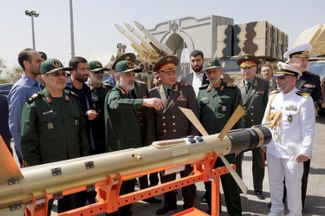
By December 2023, the two sides had signed a contract for those missiles. The following fall, the United States, France, Germany, and the United Kingdom publicly accused Iran of supplying them. Moscow and Tehran denied the allegations.
For Russia, the Fath-360 would have been useful for striking targets near the front line. That, in turn, could have allowed the Defense Ministry to conserve its own precision-guided munitions — such as Iskander missiles — for higher-value targets deeper inside Ukraine, says Leviev.
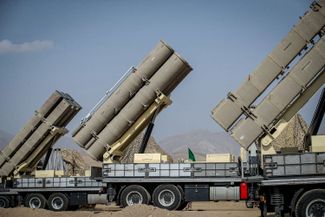
But so far, the CIT team has found no evidence that the Fath-360 has ever been used on the battlefield.
“I call the Fath-360 ‘Schrödinger’s missiles,’ because in not a single photo has surfaced,” Leviev told Meduza.
Where these mythical missiles are is a mystery. It’s puzzling, because North Korea’s Koksan self-propelled cannons and M-1991 multiple rocket launchers appeared at the front just three or four months after the first reports of their deliveries [in fall 2024 and summer 2023, respectively]. We’ve also seen plenty of photos of Iranian 120-millimeter mortar rounds. And the Russian Defense Ministry itself has even published a video showing Iranian rockets for Grad launchers.
It’s possible, Leviev says, that reports of the Fath shipments were deliberate disinformation planted by Russian intelligence services. “On the other hand, Ukraine’s military could have destroyed the missiles before they were ever deployed — with their strikes on the very same Kotluban,” he adds.
Ukraine has, in fact, repeatedly targeted every link in the supply chain carrying Iranian weapons to Russia. On April 18, 2025, Ukrainian drones attacked Port Olya; according to the Telegram channel Shot, Russian air defenses downed one drone, and its wreckage fell into the Bakhtemir River. On August 15, 2025, Ukraine struck the cargo ship PORT OLYA-4 while it was docked in Olya; media reports said it was loaded with munitions from Iran. In May 2024, a Ukrainian drone strike derailed a train bound for Kotluban carrying a shipment of explosives. And in November 2023, local media reported that an entire “train of munitions” had blown up at Kotluban. Ukraine’s General Staff has explicitly described the targets of such attacks as “trains carrying Iranian missiles.”

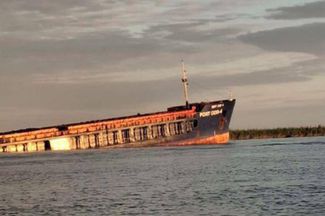
“The effectiveness of Ukrainian strikes on Russian depots often comes down to luck,” Leviev explains. “If a drone hits the ammunition directly and ignites it, you get a secondary detonation. And if the weapons are stored in the open, most of them will burn.”
In January 2025, Russian President Vladimir Putin and Iranian President Masoud Pezeshkian signed a strategic partnership agreement. At the time, the Kremlin said it would cover everything from cultural and humanitarian cooperation to military and political ties. Yet both countries continue to deny weapons deliveries.
Iran’s Foreign Ministry spokesman Nasser Kanaani has said that linking Tehran’s cooperation with Moscow to the war in Ukraine is simply an attempt to justify Western arms supplies to Kyiv. And Russian Foreign Minister Sergey Lavrov dismissed U.S. accusations of missile shipments outright. “If the U.S. invents 10 falsehoods a day, accusing us of every sin under the sun, that means nothing,” he said. “It only means they don’t like Russia itself as a competitor on the international stage.”
We usually do the talking at fundraisers. This time, we’ll let our readers speak for us. “Dear stranger, if you can support Meduza on our behalf, please do. And we’ll be here supporting our fellow citizens who are being persecuted and stripped of their freedom by Russian authorities. Thank you to everyone who helps journalists tell the truth, talk about things that matter to society, and give us the information we need to grow and persevere.” — Yulia
